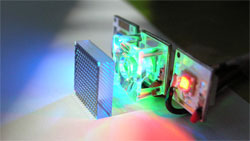Mini-projector for smartphones

The LED projector consists of an array of hundreds of tiny microprojectors. © Fraunhofer IOF<br>
It‘s convenient to be able to show people vacation snapshots on a smartphone. Butpicture details are often hard to make out – the display is simply too small. A new LED projector could help: You position the smartphone in a small cradle on a coffee table, for instance, and it projects the image onto the table top: crisp, bright and DIN A4 size. If a user wants to zoom in on a portion of the picture, they can swipe the projection with their finger the same way they would swipe a display screen – the projected image can be controlled using the same principle as the display itself.
Modeled after compound eyes in insects
The special thing about the LED projector: the entire image displayed, such as a vacation snapshot, is crisp and clear – even if projected at a very fl at angle with the beams striking the table surface at a diagonal. Usually, this would distort the picture and make it blurry in places. The researchers who developed the projector at the Fraunhofer Institute for Applied Optics and Precision Engineering IOF in Jena were able to solve this problem, though: “Our projector consists of hundreds of tiny microprojectors in an array, each of which generates a complete image,“ explains Marcel Sieler, a scientist at IOF. “This technology, known as ‚array projection,‘ is modeled on nature – on the compound eye found in some insects – and with it for the fi rst time we can create very thin and bright LED projection systems with tremendous imaging properties.“ In the simplest case of vertical projection onto a level surface, each of these tiny projectors casts the same image onto the viewing surface. Hundreds of individual images overlap to create a sharp and bright overall picture. But if the device is positioned at an angle to the “screen,“ each little projector shines a slightly different image. Just how these individual images will have to look in order to create a sharp overall picture is a function of the angle at which the image is projected, and of the geometry of the “screen“ itself.
This is because each projector in the array has a slightly different perspective of the overall scene. The large depth of focus of the micro lenses enables these key features: even free-form screen geometries such as curved surfaces can be used. The experts refer to this as the projector‘s “tailored focus“ capability. Each of the individual images is computed using software the researchers have developed: the position sensor and the smartphone‘s camera could deliver the geometric information, which the software uses to perform its calculations and compute the individual images along with their focus setting.
The optics were manufactured on wafers containing around 300 chips, each in turn housing 200 lenses for the microprojectors. “The manufacturing process is suitable for mass production, and that makes the devices economical to make,“ Sieler points out. The sensors that tell the smartphone whether and how the user has used the projection as a control field are already state-of-the-art technology: “The image is overlaid with infrared lines invisible to the user. If the user‘s fi nger breaks one of these lines with a swipe motion, for instance, the sensor registers this and advances to the next image,“ Sieler explains.
It will still be another three or four years before the projectors appear on the market: the new projection technology requires a high pixel density on the part of the digital imaging system. The researchers will premiere their prototype of the new LED projector at the Optatec trade fair being held May 22-25 in Frankfurt; the prototype is suitable for initial use on static images. The device itself measures just 2 x 2 cm in size (Hall 3, Booth D50 + D51).
Media Contact
All latest news from the category: Trade Fair News
Newest articles

Self-Destructing Cancer Cells: Cutting-Edge RNA Breakthrough
Jülich scientists use novel RNA technology to selectively switch off tumours in the brain. An Adaptable Platform Technology That Destroys Glioblastoma Cancer Cells Using a special RNA molecule, a team…

Endurance Training: Transforming Lives of Heart Failure Patients
Can strength and endurance training be beneficial for patients with a certain form of heart failure? A research team from Greifswald investigated this question together with seven other research centers…

A Wake-Up Call for Mediterranean Shark Protection Against Extinction
Overfishing, illegal fishing and increasing marketing of shark meat pose significant threats to the more than 80 species of sharks and rays that inhabit the Mediterranean Sea, according to a…



